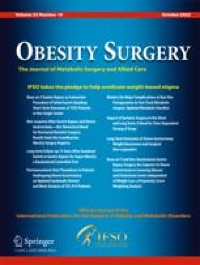Abstract
Background
The one anastomosis gastric bypass (OAGB) was first described in 2001 as a safe and effective procedure that meets the criteria for the "ideal" weight loss operation. However, revisions for malnutrition and liver failure were reported.
Case Report
We report a patient who was transferred to our institution with protein calorie malnutrition and liver failure after undergoing OAGB.
Methods
A 42-year-old morbidly obese female patient underwent a laparoscopic sleeve gastrectomy (LSG) in 2012 followed by conversion to OAGB in 2018 for weight regain at another institution. Nine months after conversion, she was transferred to our institution with dehydration, vomiting, dysphagia, generalized edema, and steatorrhea (7 times/day). She had become wheelchair bound. On examination, there was gross edema, protein–calorie malnutrition, dermatitis, and muscle wasting. She had anemia (8 g/dl) reference range (11.5–15.5 g/dl), bilirubin (1.8 mg/dl) (0.2–1.2 mg/dl), hypoalbuminemia (1.4 g/dl) (3.5–5 g/dl), and elevated international normalized ratio (INR). The patient was admitted to the hospital and was started on total parenteral nutrition (TPN), with thiamine, vitamins, iron injections, and trace mineral replacement. Her course was complicated by multiple episodes of line sepsis and bacteremia. After 6 weeks, we succ eeded in raising her albumin to 2.9 g/dl and proceeded with surgery.
Technique
Laparoscopic exploration started with identifying the anatomy and measuring the biliopancreatic limb (BPL = 430 cm) and the common channel (CC = 380 cm). First, we restored the continuity of the small bowel. Then the long gastric pouch was trimmed. Finally, the patient was converted to a Roux-en-Y gastric bypass (RYGB) with a 30 cm BP limb and 70 cm Roux limb. The patient had an uneventful recovery and was discharged home on the fourth postoperative day. At 3 months of follow-up, her symptoms resolved, her laboratory work up normalized, and she regained mobility.
Conclusion
Malnutrition and liver failure after OAGB are not uncommon. It is encountered with configurations of longer BP limb. BPL length of 150 to 200 cm seems to reduce such complications. Preoperative nutritional optimization is key. Conversion to a proximal RYGB is a safe and feasible approach.



Δεν υπάρχουν σχόλια:
Δημοσίευση σχολίου
Σημείωση: Μόνο ένα μέλος αυτού του ιστολογίου μπορεί να αναρτήσει σχόλιο.